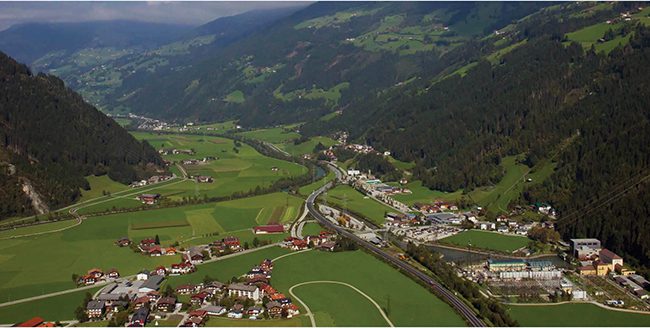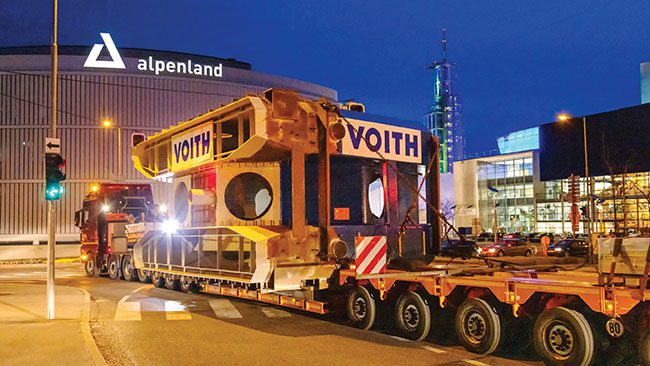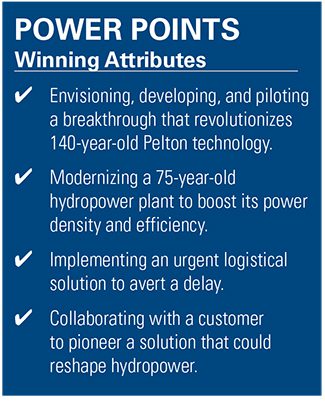Hydropower Horizons: Pioneering a Pelton Turbine Breakthrough
 |
Voith Hydro in 2022 replaced four vertical Pelton turbines at Verbund’s 75-year-old 326-GWh Gerlos 1 hydropower facility in Austria with a first-of-its-kind horizontal six-nozzle Pelton turbine. Revolutionizing 140-year-old Pelton technology, the innovation is poised to transform efficiency, reduce costs, and enhance flexibility—attributes that could give the hydropower sector new leverage to modernize.
In the late 1870s, American inventor Lester Allan Pelton devised the Pelton wheel, an impulse-type hydraulic turbine, to enhance energy generation in Western mining operations, which typically used lower-volume mountain streams. The hydraulic turbine employs a straightforward design, oriented horizontally or vertically, comprising a large circular wheel (the runner) with elliptical cup-shaped blades (buckets) affixed to a rotating shaft (the rotor). Upon propelling a high-velocity water jet through a nozzle (or injector) from the penstock—which connects to the water reservoir—the water strikes a bucket on the Pelton wheel, generating a force that sets the turbine in motion. The rotating shaft powers a generator for electricity production.
While the first Pelton turbines were positioned horizontally, they were limited to one or two nozzles to control backsplash, which could slow down the runner—and ultimately reduce the turbine’s efficiency. To increase their output with more nozzles, Pelton turbines installed from the 1950s have generally featured turbines with vertical shafts, commonly equipped with four to six nozzles, a configuration that allows water discharged by the buckets to be drained upwards and downwards with relatively less effort.
For more than 10 years, researchers at Voith Hydro, a long-time German manufacturer, have been pondering how to resolve the essential challenge of outfitting Pelton turbines with three or more nozzles horizontally without sacrificing performance. The main driving factor for the HP3+ initiative—Voith’s strategic development to advance the breakthrough—was to “improve power density while making maintenance easier,” Reiner Mack, a Voith Hydro development engineer, told POWER. “Increasing the number of nozzles increases the power density and thus also the rotational speed. As a result, both the generator and turbine can be built smaller,” he noted.
At the same time, “Servicing a horizontal machine is much easier than a vertical shaft because everything is on one level in a horizontal arrangement.” General maintenance of vertical machines often requires additional effort to create a safe working environment. Construction is also markedly more accessible given that horizontal machines don’t need multiple levels and can be placed on top of existing foundations, he said.
Digital Fine-Tuning Yields a Revolutionary Solution
Putting the concept into practice, however, required substantial creativity to resolve the Pelton turbine’s fundamental water management. The solution required effectively utilizing the available space “by using a cone that acts both as a baffle plate for the outflowing water, and as a drain for the water that would fall back onto the runner without the cone,” essentially preventing the runner from being slowed down by backsplash, Mack said.
In the beginning, Voith’s research team created some “relatively simple” simulations to confirm the conical shield housing concept would work. The initial computational effort proved to be a big lift, Mack noted. “Housing flow is very complex, and 14 years ago, computers were not as capable as today.” However, the rudimentary simulations showed promise, so Voith pressed on with modeling with experiments as well as with simulations, which ultimately helped the team refine a housing concept.
“Computational fluid dynamics played a big role,” Mack added. “Basically, the whole thing housing of a Pelton turbine is around 95% filled with air, and only 5% of the space is filled with water,” he said. Compounding the challenge is that, owing to its very high heads, the interaction between the water jet and the buckets of the Pelton wheel is concise—often just a few milliseconds. “Today, we have a different technology where only the water sheet development inside the air is calculated.” That’s important because “the housing itself is relatively close to the runner, and we needed to optimize the situation so the water that comes out of the runner doesn’t fall over it and will be redirected to the runner” without being impeded by parts that are situated in between the nozzle and runner, he said.
The final concept uses a circular or polygonal cover sheet around the runner that serves on one side as a guide vane for the discharging water and on the other side as a protection for the runner from back splashing water. “The housing is more complex and larger. However, it provides a much higher power density than two-jet [horizontal] machines,” Voith noted.
An Innovative Customer
According to Mack, a critical prong that shepherded development of the concept has been interaction with Voith’s customers, specifically customers confident in the elaborate power engineering involved and who trusted the company to “deliver what it promised.” After extensive tests and pilot programs, Austrian utility Verbund agreed to pilot the technology at Gerlos 1, a hydropower facility in Austria’s scenic Ziller Valley.
Built in several stages between 1939 and 2007, the 317-GWh project’s four vertical Pelton turbines—a combined capacity of 65 MW—were approaching the end of their technical lifetime. While the project specification originally envisioned replacing the four existing vertical turbines with two conventional horizontal Pelton turbine units (each outfitted with two nozzles), Voith’s overhaul proposed a single 80-MW horizontal turbine with six nozzles. Making use of the existing space more effectively was a significant driver, Mack noted. “The powerhouse ceiling was too low, and the powerhouse area was too small for a vertical one,” he said. Running at 500 revolutions per minute (with a maximum head of 617 meters [m] and a maximum discharge of 16 cubic meters per second), the newly developed turbine achieves an efficiency level that compares to vertical machines featuring the same number of nozzles and the same runner installed, Voith underscored.
A Logistical Swerve
Still, installing the single turbine presented notable challenges that required innovative and diligent problem-solving. After the four older units were dismantled, the scope of work involved modifying the new unit’s penstocks and installing the new turbine and generator components. Fitting the innovative turbine in the existing structure required close coordination with Verbund, Thomas Eismayer, Voith Hydro’s project manager for delivery of the turbine, told POWER. “On the one hand, attention had to be paid to minimum interference on the existing civil structure while, at the same time, we had to comply with the hydraulic specifications,” he said.
 |
|
1. Voith Hydro deployed a heavy transport operation to get the 54-ton housing for its innovative six-nozzle horizontal Pelton turbine from its manufacturing facility in St. Pölten, Austria, to Verbund’s Gerlos 1 plant site in the Ziller Valley in Tyrol. Courtesy: Voith Hydro |
The biggest challenge, however, entailed heavy transport of complex parts to the plant site, particularly given the site’s remote location, said Eismayer. Gerlos 1 is located at the southern end of the holiday resort village of Rohrberg in the Zillertal on the steep slope of the Rohrerberg. For example, the turbine’s first-of-a-kind housing was manufactured at just under 9 m long, more than 6 m wide, and more than 4 m high. It weighed a stunning 54 tons. Though Voith Hydro began manufacturing the turbine housing in Italy, Austrian authorities abruptly announced an unexpected highway construction project, forcing Voith Hydro to reconsider its carefully strategized logistical plan, Eismayer said. Acting urgently to meet the delivery date, Voith Hydro decided to transport the housing earlier. Leveraging its in-house flexibility, the company shifted to finalizing the housing’s manufacturing at its facility in St. Pölten, Austria, and prepared to deliver it using a different route (Figure 1).
As part of the “logistical masterstroke,” the heavy transport operation was completed within three nights, Voith Hydro noted. Diligent logistics were also required for the turbine, as well as for the installation’s other complex parts. “Here, again, it pays off that we’re talking about one unit replacing four,” the company underscored.
Spurring a Pipeline of Projects
The pioneering six-nozzle horizontal Pelton turbine was ultimately put into operation in October 2022, and it has since operated as designed. Voith Hydro noted the successful operation at Gerlos has spurred interest worldwide. A second project featuring two HP3+ turbines is now under development to replace five vertical turbines at Illwerke’s 157-MW Vermuntwerk in Vorarlberg, Austria. “We have several inquiries, one from Italy and one from India, regarding the same concept,” said Eismayer.
Mack added that a substantial market opportunity for the turbine exists at hydropower plants equipped with Pelton turbines in South America, Norway, the Alps, and the Himalayan region, where many existing turbines were built after the war. “The big advantages would be in retrofits and modernization simply because you can replace existing turbines by increasing the power without too much work in the civil structure—and that, of course, helps you in the complete cost,” he said. “However, for new powerhouses, this makes sense when the maintenance of horizontal machines is compared,” he added. Compared to conventional horizontal solutions, “this machine makes a much smaller building—the powerhouse itself is around 30% smaller compared to a traditional horizontal machine,” he said.

Innovation Requires Confidence
Voith Hydro credits its team’s experience and flexibility in completing the first-of-a-kind project on time and within budget. Crucially, however, the company also highlighted its long-standing relationship with customer Verbund. “Our business is actually a rather conservative business,” noted Eismayer. Pairing with an innovative customer like Verbund that had confidence in the solution was vital to get the revolutionary concept to a successful pilot, he said. Eismayer also underscored the importance of good communication for successful first-of-a-kind project execution. “The benefit of working with Verbund is that we have a really good relationship, and they are technically also experienced, which was important for effective communication during the design phase,” he said.
Mack, who steered the turbine through its conception, prototype, and ultimately, realizing it as a commercial product, in addition pointed to company vision. “Developing a solution like this requires members of management at Voith who have the necessary vision to see that such an idea will be successful,” he said.
—Sonal Patel is a POWER senior associate editor (@sonalcpatel, @POWERmagazine).